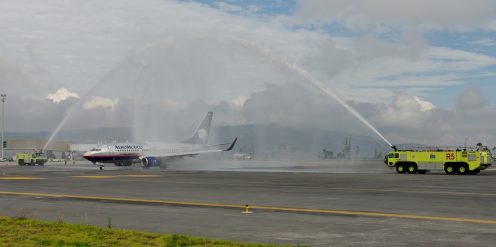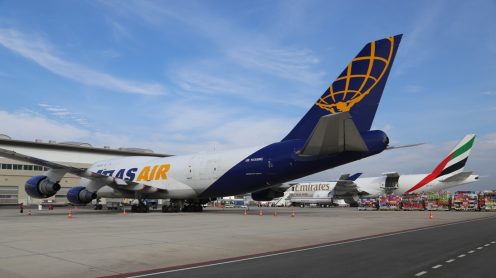Dave Appleby, Director - Latin America & the Caribbean, Routes and ASM Ltd provides more details on a successful first year of operations at the new Quito International Airport in Ecuador.
On February 20, 2013, the New Quito International Airport opened its doors to the more than 5 million passengers that annually visit Quito and Ecuador. The start of operations at this important infrastructure was extremely necessary considering that the previous airport was located in the middle of city, with no possibility of expansion and in fact it was considered a hazard for the community.
This only Greenfield airport in the region offers modern and efficient infrastructure for airlines as well as passengers. Some of the key operational features that airlines can take advantages of include improved take off performance with more payload and fuel capacity, the ability for larger airplanes to operate on the 4,100 meter long runway; safer operations with lower landing approach minimums; navigational aiding system to safety regulate approaches, navigation and aircraft landings and compliance with all ICAO regulations. Additionally, the terminal building offers more efficient passengers processes as well as an improved shopping experience with 26 locations that provide a great variety of products and services.
For the past eleven months, Quiport, the concessionaire in charge of constructing, operating and maintaining the new facility, has been concentrated in improving and growing different aspects of the new aerodrome. The company is committed to working closely with the airlines as its main strategic partners in the development of the Quito Airport City – a concept that reflects the new reality of the aviation industry in Quito, Ecuador where safety, efficiency and comfort are the pillars for a successful and sustainable operation.
An important strategy for the company over the past eight years has been the work done on route development which has included participating in key industry events such a Routes Americas and World Routes, as well as visiting airlines headquarters to keep them informed about the market opportunities that can be considered thanks to the operational advantages the new airport offers.
Another important aspect of route development strategy has been implementing several incentives for airlines to either increase frequencies or develop a new route. Quiport has ensured the support of the municipal and national government for these incentives as part of the overall program.
The work done on this field has already started to show results. New frequencies and routes demonstrate the confidence airlines have in the airport development of Quito. Since the opening of the new airport we have seen these important milestones in route development: Tame (Ecuadorian flagship airline) new route to Buenos Aires implemented in June; KLM implemented 6th and 7th weekly frequency; Iberia started operating 3 non-stop flights to Madrid and Aeromexico started new non –stop route Quito-Mexico.

The airport’s cargo business has also seen important changes in the past eleven months of operations. In June, the airport welcomed the first landing of a Boeing 747-8F operated by Etihad Cargo which is currently now flying in three times a week. In addition, Emirates SkyCargo started a trial operation in December with impressive results which the airport hopes may lead to a regular operation.
A key feature to highlight is the strong coordination with the authorities including the Ministry of Tourism in order to jointly market Quito and Ecuador as an important tourism and business destination and ensure efforts by both the public and private sector are geared towards the same market targets.
Opening the new airport was only the beginning of many further changes and improvements for the city’s aviation sector. From an operational perspective, Quiport has worked with the Civil Authority to increase the airport’s operational capacity by obtaining new minimums for approaches and take-offs under instrumental meteorological conditions. And it is currently installing runway center line lights which will increase the operational capacity of the airport.
In terms of infrastructure, since the opening of the airport, Quiport and its main partners have invested over $74 million in the developing of Quito´s Airport City. These investments include: a new Logistics center to further improve cargo operations; new Corporate centre connected to the terminal which provides a food court, additional commercial services and office space for airport users; a new International VIP lounge with over 600 sqm that allows passengers to better enjoy their waiting time; expansion of the Duty Free store located in international departures from 230 square metres to 830 square metres. The store includes important brands such as Hugo Boss, Mont Blanc, Salvatore Ferragamo, Cartier, Tommy Hilfiger, among others and the start of work on a five star, 140 room hotel in a 20,000 square metre area.
Quito has seen an important increase in the volume of passengers that pass through the airport over the past six years which is a trend that continued in 2013 and it will most likely follow the same direction in the upcoming years thank to the promotion the city and country are getting in the international scene. In fact, in June 2013, Quito won the South America´s Leading Destination from the prestigious World Travel Awards, competing against important destinations such as Lima, Bogota, Buenos Aires, Sao Paulo, among others. And in November 2013, Ecuador received from the same organisation the World´s Leading Green Destination 2013 award.
With this expectant growth in passenger volume, Quiport has already announced the beginning of the construction works for a Phase 2A expansion as part of its Master Plan. The total investment will be approximately $15 million and it will include a new area of 5,260 square metres and two new passenger boarding bridges. This will allow the terminal to handle 51 per cent more passenger capacity during peak hour.

The expansion also includes improvements for the cargo operations given that forecasts indicate a potential growth of 28 per cent for the key flower cargo season. Plus, certain cargo airlines plan to operate more frequencies and are studying potential fleet changes to take advantage of the operational improvements of the new airport. In the cargo area, the expansion includes an additional 14,000 square metres located on the south side of the current platform and a connecting taxiway of 13,754 square metres. This area will have the capacity to park up to two category E aircraft (Boeing 747, 777, Airbus 340).
Quiport plans to continue with the route development program and key activities are already in the agenda including a visit to Air Canada in Montreal, as well as a technical meeting in Quito with representatives from JetBlue Airways over a potential flight to Fort Lauderdale. The company will also participle in the upcoming Routes Americas event in San Salvador, El Salvador where it plans to meet with about 30 airlines to discuss increased frequencies and new destinations. It will also continue working closely with the Municipal and Central government to further promote Quito and the operational advantages that the new airport provides.
The vision for Quiport is to be the leader in the airport industry of the country and the region, and at the same time, be an engine of social and economic development for Quito and Ecuador. And in only eleven months of operations, they have proven to be working hard at achieving this goal thanks to the collaboration of all airport operators, the authorities and the community at large.
You can find out more, and like Quito International Airport, register for Routes Americas 2014 here.






